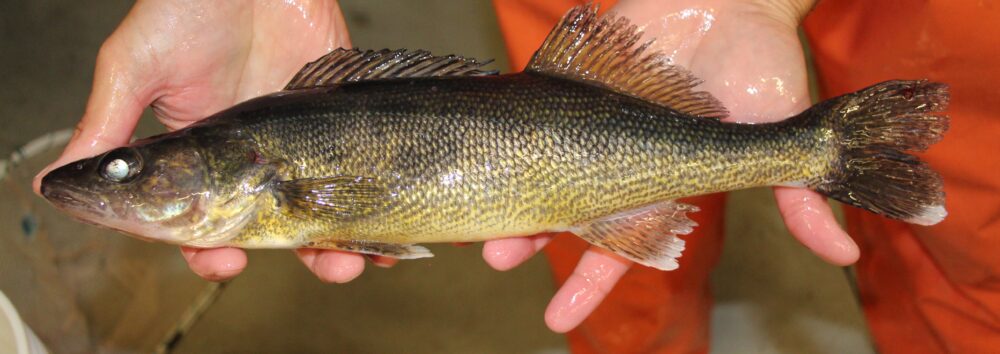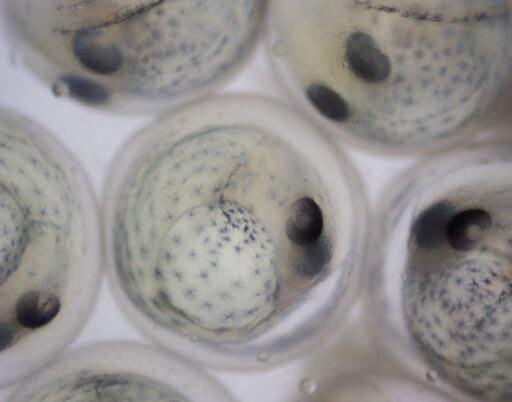Identifying the Thermal Requirements for Successful Reproduction of Walleye
FUNDED BY: NOAA NATIONAL SEA GRANT COLLEGE PROGRAM
THE BACKGROUND
Walleye (Sander vitreus) is recognized in the National Aquaculture Development Plan as a species with substantial aquaculture potential because of its high market value and limited supply from traditional commercial sources. Walleye is one of the most valued food fish in Wisconsin, but most are from capture fisheries imported from Canada. UWSP NADF has experienced substantial success over the past 15 years raising walleye intensively in recirculating aquaculture systems and have been able to assemble a systematic culture protocol that has advanced walleye food fish production to the point that a Midwest area commercial walleye industry is emerging.
 Walleye raised in water reuse systems at UWSP NADF
Walleye raised in water reuse systems at UWSP NADF
THE BOTTLENECK FOR COMMERCIALIZATION
Effective broodstock management and the ability to control reproduction is the cornerstone of a sustainable aquaculture industry. Understanding the factors that comprise broodstock quality and support offspring performance are central to industry advancement and economic growth. Currently, there is a gap in knowledge about what thermal conditions are required during the winter months for successful walleye reproduction. Walleye and other percids require a period of cold water temperatures during winter for successful gonadal development, but the specific temperatures and duration of this chill period are unknown. This information is critical for the development of a successful intensively reared walleye broodstock. Additionally, the costs of chilling water can be considerable so identifying how cold this chill period must be can provide valuable economic information to aquaculturists interested in developing a walleye broodstock.

Effective broodstock management and the ability to control reproduction is the cornerstone of a sustainable aquaculture industry.
BUILDING UPON PREVIOUS WORK
Our most recent walleye project, funded by Wisconsin Sea Grant, “Commercial application of out-of-season spawning of walleye (Sander vitreus)”, is succeeding in completing the full life cycle of walleye reproduction under intensive conditions within a land based, sustainable, recirculating aquaculture system and is providing the methodology for supplying suitable eggs and fingerlings to a growing commercial walleye industry. While this project demonstrated the feasibility of out-of-season spawning for walleye, it also highlighted the importance of winter chill periods for successful broodstock reproduction. In this study, walleye brood held on an extended winter chill period had poor reproductive success suggesting the duration of the chill period was too long. Additionally, intensively reared walleye with chill durations similar to those experienced in the wild had lower reproductive success than their wild counterparts suggesting winter chill period temperatures may not have been sufficiently cool.
Funded by Wisconsin Sea Grant
Commercialization of Walleye
Out of Season Spawning of Broodstock
NEXT STEPS
Our research objective seeks to address a critical gap in our knowledge and provide much needed insight on the culture conditions to meet the physiological requirements of walleye broodstock. This information is critical for furthering the commercialization of walleye production in North America.
OBJECTIVES:
The overall project goal is to identify the chill period thermal conditions that are most optimal for broodstock walleye reproduction.
Specific objectives are to:
1) Compare walleye broodstock performance when exposed to a variety of winter chill period temperatures.
2) Compare walleye broodstock performance when exposed to a variety of winter chill period durations.
3) Compare egg biochemical composition (fatty acids, lipids) from in-house broodstock under various chill temperatures and durations.
4) Compare egg, fry, and fingerling performance parameters and biometric factors.
5) Demonstrate and transfer information to Wisconsin’s aquaculture industry through outreach activities that will distribute project results and deliverables such as broodfish protocols and thermal schedules.